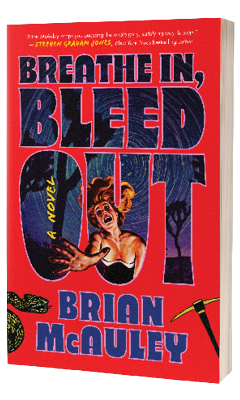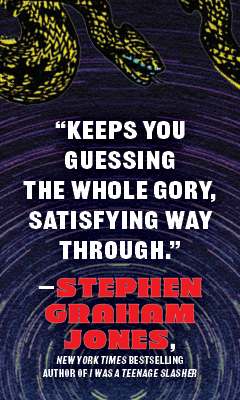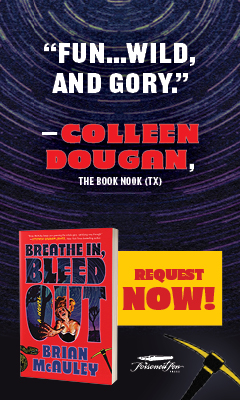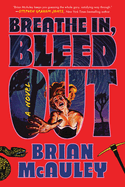Breathe In, Bleed Out
by Brian McAuley
Breathe In, Bleed Out follows a protagonist who is tough but deteriorating, as she travels into the southern California desert with a group of old friends for what should be a relaxing retreat. It turns out to be anything but. Brian McAuley (Curse of the Reaper; Candy Cain Kills) brings horror, snarky humor, and an array of increasingly inventive deaths to this reunion-turned-nightmare road trip.
"Dragging a body through six inches of snow is even harder than I expected," begins Hannah's narrative. This is only the first in a series of nightmares, flashbacks, and hallucinations in which she will revisit her fiancé's demise on a winter hiking trip gone wrong. Ben was the outdoorsy one, who had introduced Hannah to experiences like their last one together, with crampons and ice axes and an enigmatic end. It will take most of the book for Hannah to reveal what exactly went wrong, leaving the reader wondering what secrets she's keeping.
As a first-person narrator, Hannah raises questions for her audience. When is she hallucinating? What really happened to Ben? How many Xanax has she had today? (She's not sure, either.)
The morning after her opening-sequence nightmare revisiting Ben's death, Hannah heads off to a shift as a medical intern at a Los Angeles hospital. Treating her grief, anxiety, and insomnia with prescribed medication, she makes an error that nearly kills a patient and gets her suspended indefinitely. It's also her birthday, and her longtime best friend Tess has been trying to reach her, although Hannah's been avoiding her friends. Now, newly freed from employment, Hannah finds her defenses weakened, and agrees to spend a weekend near Joshua Tree at a swank "healing retreat." It's so exclusive that there's no web presence at all, just a shadowy leader who calls himself Guru Pax. "There are few things more gross than the G-word in LA wellness culture, where self-appointed experts prey upon the insecure and the vulnerable," Hannah confides to the reader; nonetheless, off she goes.
Tess, "the emo girl turned Wicca woman," is recently off yet another breakup, furthering her "serial-relationship status." The best friends are joined by Luna, formerly Lauren, a "certified trauma-informed yoga instructor." Hannah sees her as a chameleon, who passes off "disordered eating as a 'health-conscious lifestyle.' " Luna's boyfriend Jared is worse still, a boozing frat boy turned boozing digital ad salesman. And then there's Miles, a hot and successful DJ with whom Hannah has longstanding, unresolved sexual tension. The fivesome heads into the desert toward the mysterious Avidya Healing Retreat.
Along the way, they stop at a little desert town for a drink, and an altercation with a local. The bad vibes stack up, complete with the purported ghost of a 19th-century bank robber-turned-gold miner (hat, pickax, and all) and an Indian burial ground. Then they are truly off-grid: upon entering Avidya, the friends must give up their phones to a young Native American woman holding a burlap sack. Tess has billed this weekend as being all about "the hot springs and sauna, the yoga and sound baths, the nature hikes and stargazing," but amid Jared's whining, Luna's posturing, and Miles's flirting, Hannah is having trouble relaxing. Her dreams and her demons have followed her into the desert, and she struggles to tell them apart from reality. And then people start dying.
Breathe In, Bleed Out opens with Ben's dead body, but his cause of death remains unexplained for much of the novel, even as the body count rises. Ben's demise, and the obvious question about Hannah's involvement, plays neatly against the puzzle of the killer at the new-age retreat. In this way, gore bookends the story, with dry wit and playful humor along the way.
McAuley takes the time to give each of Hannah's friends a backstory, developing them beyond type. While the bulk of the novel is told in Hannah's first-person perspective, other characters enjoy brief sections in the spotlight, in close third person. As the Avidya retreat turns bloody and then bloodier, readers' sympathies will be expertly turned one way and then another through a series of ever-more-elaborate kills worthy of any slasher flick--the sauna, the hot spring, and the crystal in the center of the pool each offer unique and cinematic opportunities for fans of a gruesome and imaginative death scene. The killer's identity remains unknown through masterful twists and turns, with one character after another appearing to be the villain. The key elements of the horror genre are all accounted for, but secrets persist: McAuley keeps his readers guessing until a final dramatic reveal.
For fans of slasher flicks with a touch of satirical wit and a sense of fun amid the bloodbath, Breathe In, Bleed Out offers an entertaining escape that will have readers rethinking the yoga prop. --Julia Kastner








